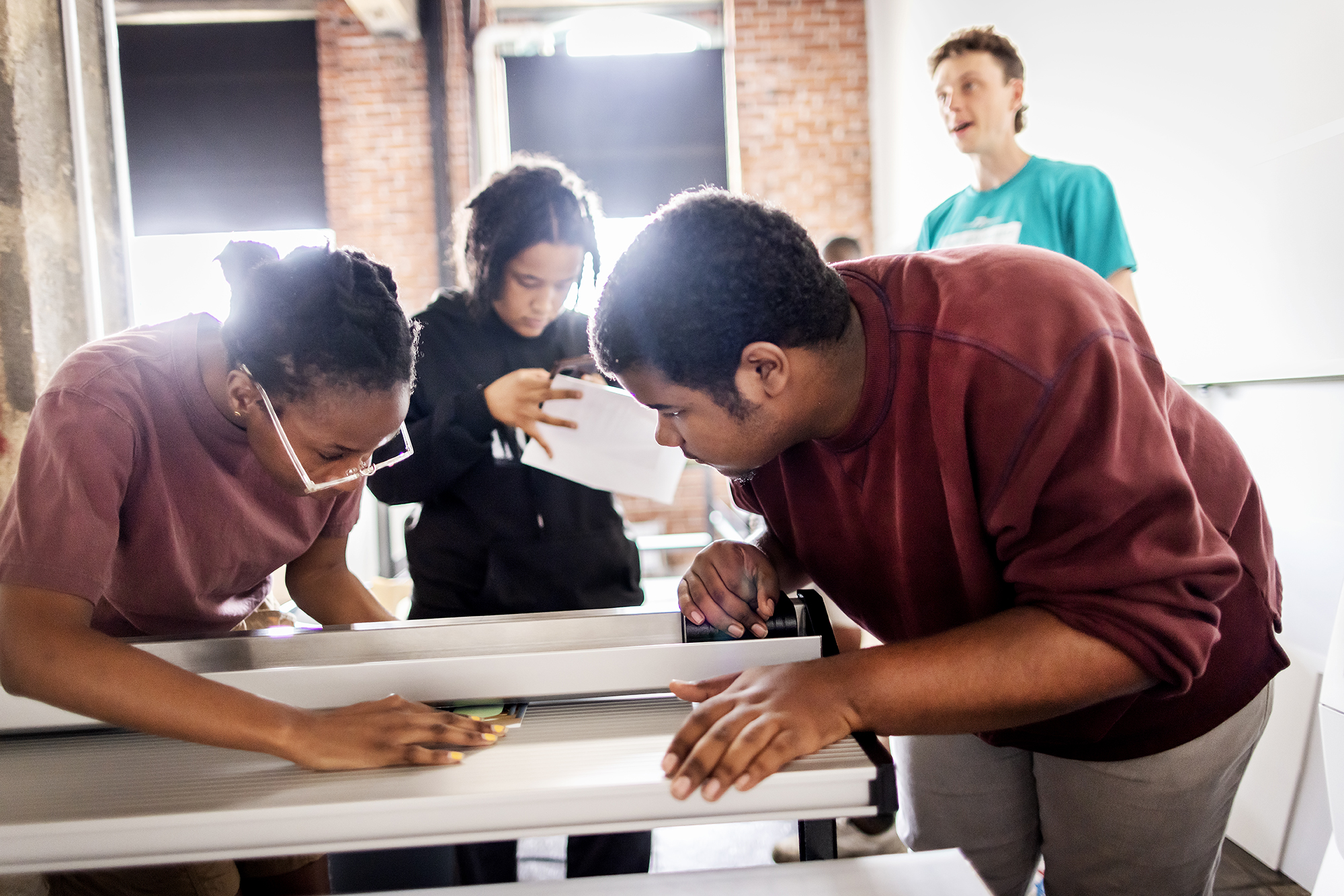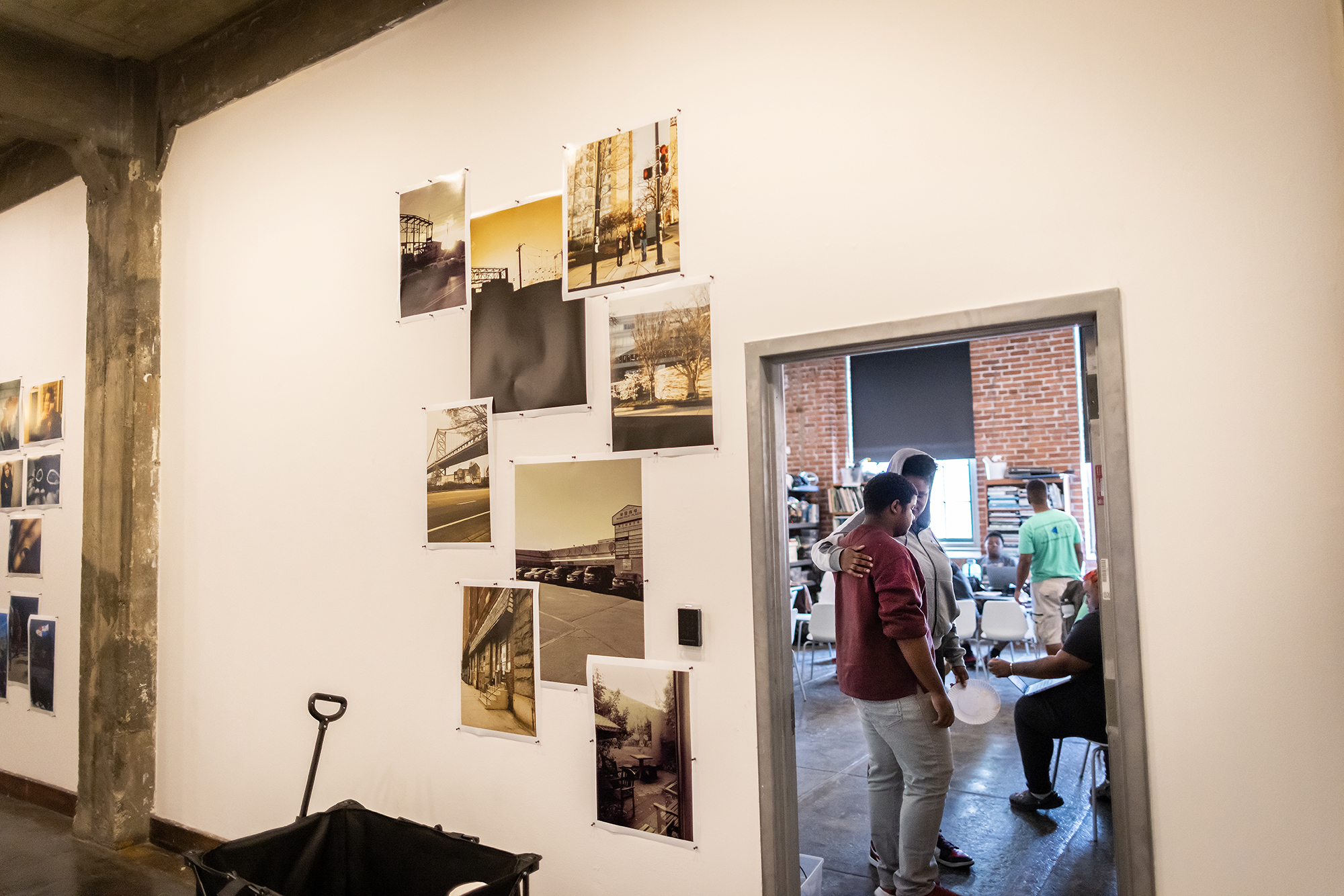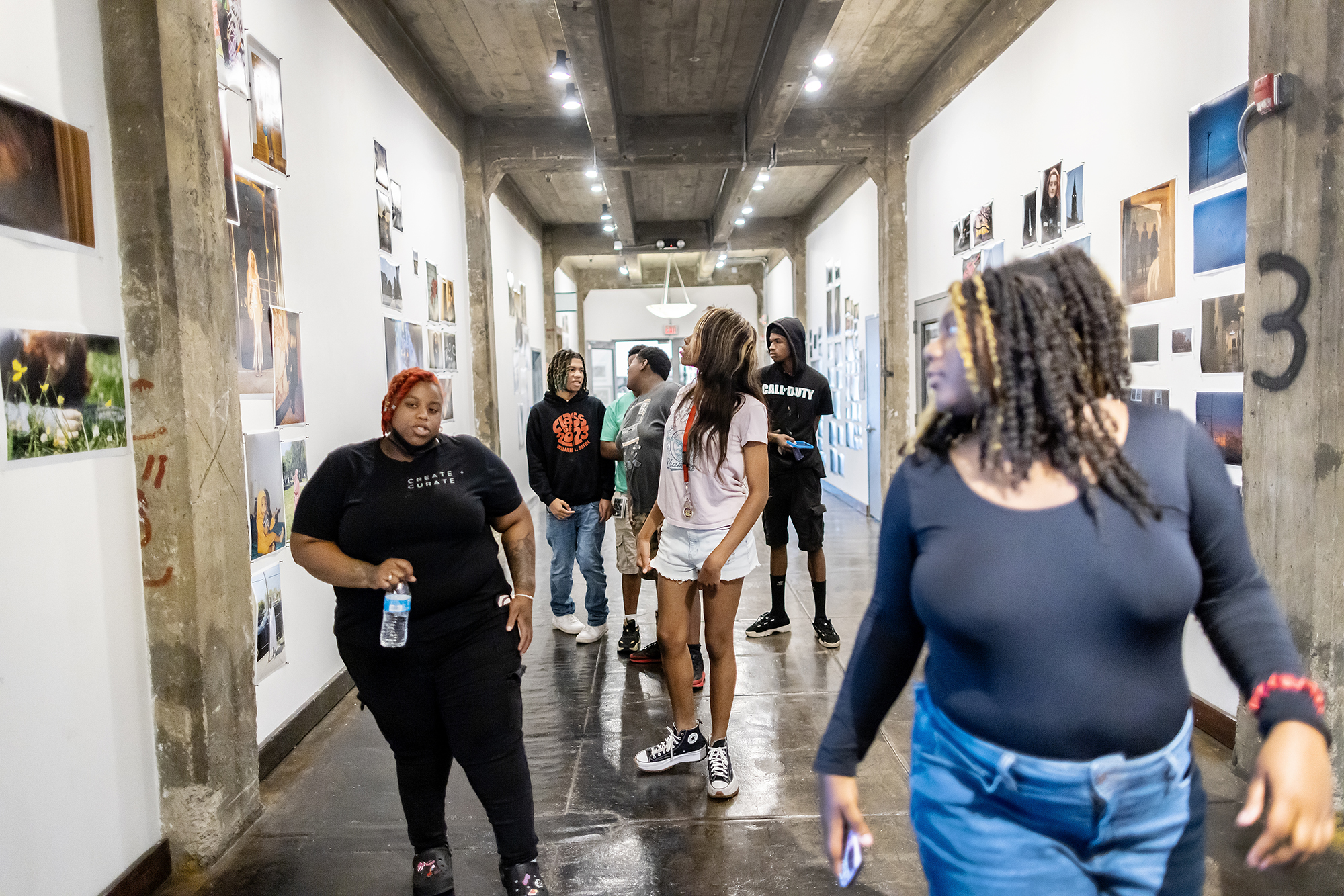
An image flashes, projected on a screen. It’s a man, long pants, long shirt, standing in sandals on a dusty street. Everything is in tones of sepia, grey, and black. All the saturation in the print is gone—except for the bags of bright-pink spun sugar that the man is selling, echoed again in the pink tones reflected through a barred window.
“Is it a good or bad photograph?” asks instructor Latifa Wright, addressing a roomful of students from William L. Sayre High School.
“Ooh, I love it. It makes contrast,” one student says.
“I got to say, he looks depressed,” another counters.
“Oh, he’s done with the candy business. He wants to give it up,” a third rejoins.
Here at TILT Institute for the Contemporary Image, the Sayre students are part of Your Food Story, a summer internship that incorporates food, nutrition, urban gardening, museum research, and art. The program is a partnership between Sayre, the Penn Museum, and the Netter Center for Community Partnerships, funded in part by The Sachs Program for Arts Innovation.
Over six weeks, 12 students in the Philadelphia public high school met experts across these fields, gardening and distributing produce to the community, learning from dieticians and museum experts, and photographing their experience. Their photography work is currently on view at the Penn Museum and will move to Sayre sometime in October.
Museum exploration
The students worked in teams, each choosing a different ingredient to focus on, connecting their ingredients to the archeological finds showcased in the Museum’s Ancient Food & Flavor exhibition, where corn and chili peppers found from archaeological sites show the enduring importance of food to the human experience.
The students looked at artifacts that became conversation starters, says Jennifer Brehm, Penn Museum’s director of learning and community engagement. “When did humans first start using these ingredients? How did they use them and preserve them?”
Sayre student Tyrell Kyseem Q. Bethea, 19, who uses both he and they pronouns, researched salt, “a little thing to me, but tasty,” they say. “I was curious where it comes from … It actually comes from a mineral, crystal, not like how I thought it would come from. I thought it would come straight from the ocean.”
At the museum, Bethea also learned that ancient Egyptians would pack dead bodies in salt to transport them down the Nile. Salt absorbs moisture, he says.
Bethea chose salt because it is one of the five basic flavors—along with sweet, sour, bitter, and umami—that taste buds perceive. “Salt is in everything,” Bethea says. “It enhances the flavor of everything else.”
Their final image was a river of salt poured out on a scratched black surface, a silver spoon creating a division between two banks of white granules. As salt absorbs moisture, Bethea used water to build volume and texture.
Bethea was nervous about working with a new instrument, he wrote in his artist statement. “At first I was worried about losing or breaking my camera,” he wrote, but says he came to enjoy the precision behind it and describes himself as an amateur artist.
Kobe Livingston, 16, chose a similar ingredient—sugar. Her photograph shows sugar pouring from a plastic liter bottle; the sugar in motion is blurry, like water shooting out of a hose.
“Even without trying to consume sugar, most of the days you are,” she says. “When I took the photo, I wanted to capture how sugar’s in almost everything.”
Livingston signed up for the program because “I’m getting paid to do something I would do for free, and with the people I care about,” she says. But “at some point, it wasn’t even about the money.”
Part of the draw was connection to friends, Livingston says.
A green garden courtyard
All 12 Sayre students were part of the University-Assisted Community Schools program garden crew, says George Janssen, the gardening and nutrition education coordinator at Penn’s Netter Center. During the school year, Janssen worked with the students three days a week to maintain the Sayre garden, share vegetables with patients and community members at the Sayre Health Center, and cook with the produce.
Janssen says the garden is in the school’s courtyard and is popular with everyone as a place of green respite. “If I see a student looking through the window, I’ll say come on in,” he says. “I’ll show some of the vegetables we have growing, give them some cherries from the sour cherry tree … Eventually they just come around.”
The cooking component is the most popular, says Janssen. Maris Altieri, Netter’s nutrition systems and education manager, helps create recipes approved by Pennsylvania’s food assistance program using the garden produce. Altieri talks with the students to find out what they’re interested in, connecting the curriculum to align with community gardening and sustainability, she says.
“All throughout the year, we were able to build these connections,” Janssen says, “and then we all came together for the summer.”
Food and photography
The internship began by easing students into topics and encouraging independence and exploration, says Wright, TILT’s teen photo lead instructor, and then having students photograph their chosen ingredients, surroundings, and community.
“So, it kind of brings the process full circle for them,” she says. “I think the idea of the culture for them is really, really important and it’s really important to hear what they have to say.”
The biggest challenge with high school students, is “getting them to trust me,” says Wright. Given the short time period, “It’s always a really, really hard battle.” Creating a safe space is important, she says.
“I have to ask them what they are best at, what they like, what they don't like. I have to respect their boundaries, too,” Wright says. “All of those things indeed affect how you learn … My main goal with all of those things is to create a classroom experience that not only safe, but whole.
“And that is far beyond photography,” she says.
By the end of the internship, the students seem comfortable with each other and with Wright, who encourages them to critique the food photography she projects on the wall, and to shout out their thoughts, as long as they don’t interrupt each other.
“One mic, one mic, one mic,” she says, calling order to the room. “What about this? Is it a good or a bad photograph?”
Wright shows the image of a person, clad in a white apron over a dark jacket. His hair is iron-grey; his face lined with age and concentration. In the foreground, a rippling ribbon of white cascades forth, defying gravity.
“It’s good,” one student says.
“Why is it good?” Wright asks.
“The composition,” someone else says.
“He’s pulling taffy,” another student says.
“I be pulling taffy too, it don’t look like that,” one counters. “He looks like a wizard. He looks powerful.”
“Don’t mess with him,” someone says.
The students have incredible stories to tell, says Danielle Morris, TILT’s director of education. “I’m very excited about the way that they are connecting with food, particularly in the way that it impacts them and their personal lives … They’re going to be a lot more conscious about what they consume, how food makes them feel, what it means to share meals with people.”
Ulyssa Lawrence, 15, has a family connection to ginger, a medicinal root that’s been cultivated for over 5,000 years, Lawrence says. Her parents are both from the Caribbean, where a lot of home remedies require ginger, she says.
While researching the ingredient at the Penn Museum, Lawrence found that ginger is originally from Asia. “It was a very big culture shock to realize how far it migrated,” she says. “It’s a very big thing all over the Caribbean.”
“Ginger also holds a special place in my family,” says Donna Robinson, 17, who uses both she and they pronouns. Their grandmother left Chile in the 1980s, in part because of the dictatorship of Augusto Pinochet, she says. Robinson’s grandmother helped her make a full menu for the students to sample: ginger-mint lemonade, ginger pear bread, chicken, rice, and ginger stew, ginger and honey-glazed carrots, and a salad with ginger dressing.
Robinson remembers her grandmother making a ginger-cucumber limeade when someone in the family fell sick. “Must have been some kind of magic, because it worked really well,” they say.
“Ginger has so many properties that work to inspire people,” Robinson says.
During the internship, students also learned about exhibition design, and were given a choice between displaying one 16x20 inch photograph or two 8x10 images. They learned about how to display photographs, how to make a mount, and each had the opportunity to write their own artist’s statement.
“Through my lens, I aim to capture the artistry of food, its intricate details, and its power to evoke emotions,” wrote Robinson. She chose to photograph the lemonade ingredients—mint, ginger, cucumber, and a lemon on a weathered, lichen-dotted picnic table in the Sayre garden.
The museum exhibition gave the students “validation that they weren’t expecting,” says Brehm, “knowing that their words matter and are important. We can say that over and over again, but until they see for themselves, they don’t feel it.”
Enlarged and printed, mounted, and displayed, Your Food Story shows Sayre students’ perspectives in their own words.
“I enjoyed capturing a moment that’s gonna last forever,” Robinson says, “the idea that I can educate or inspire people just by an image.”









